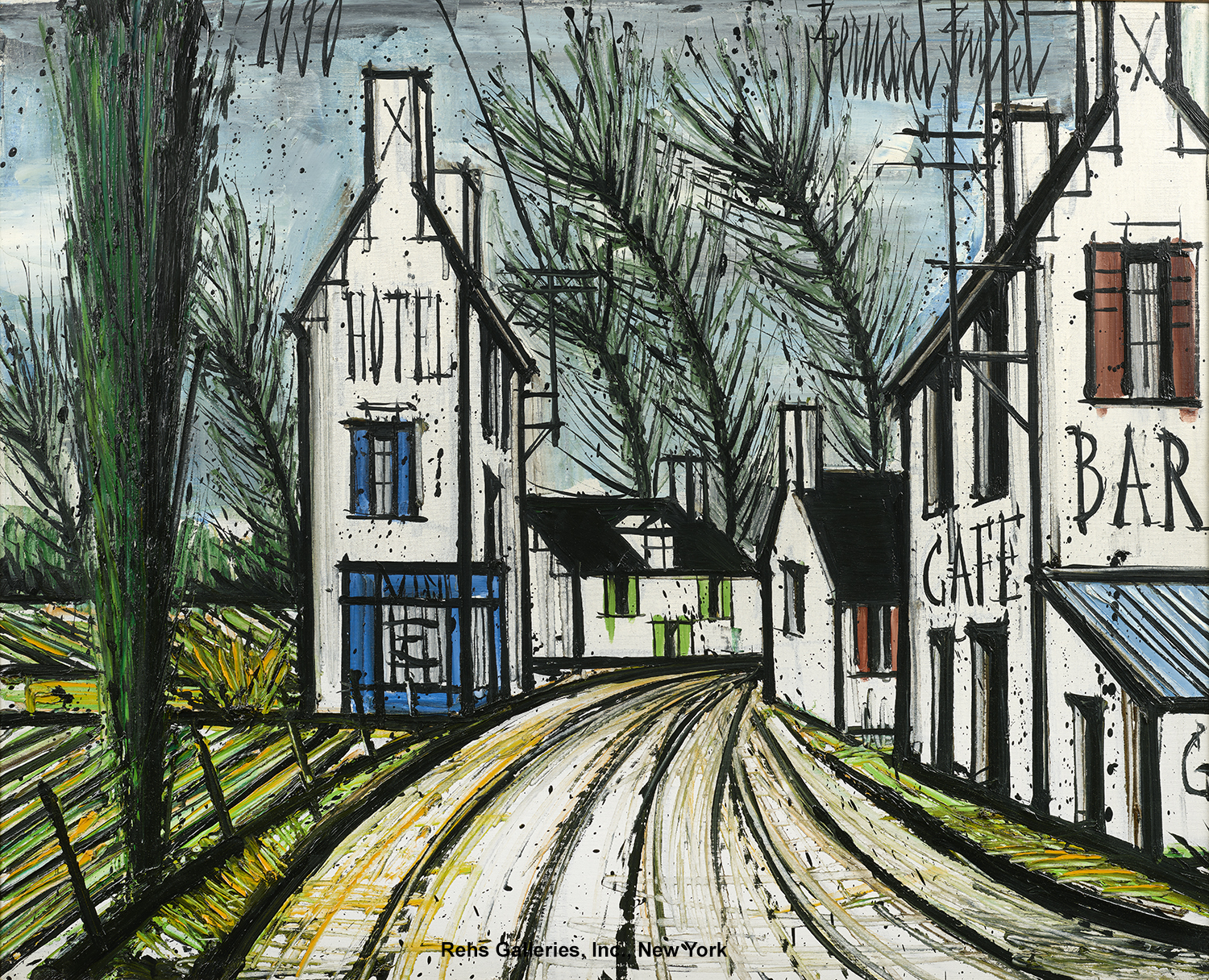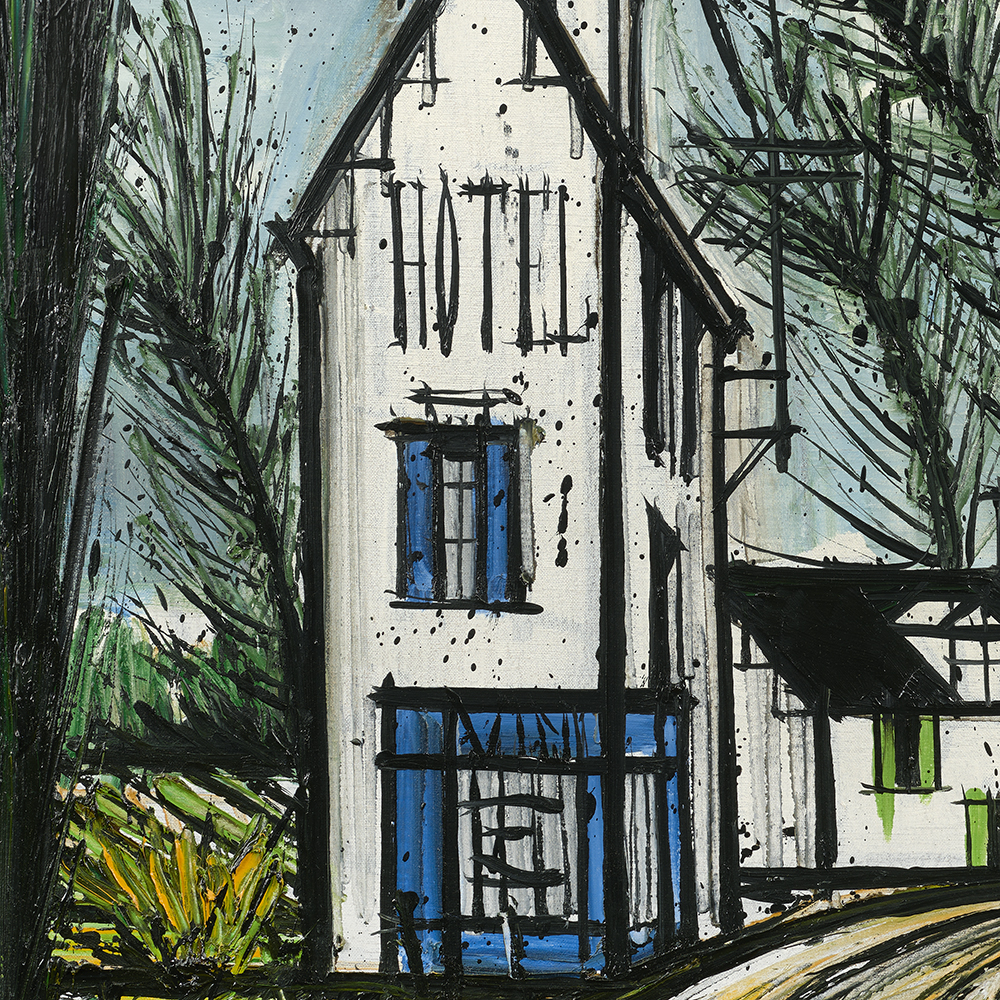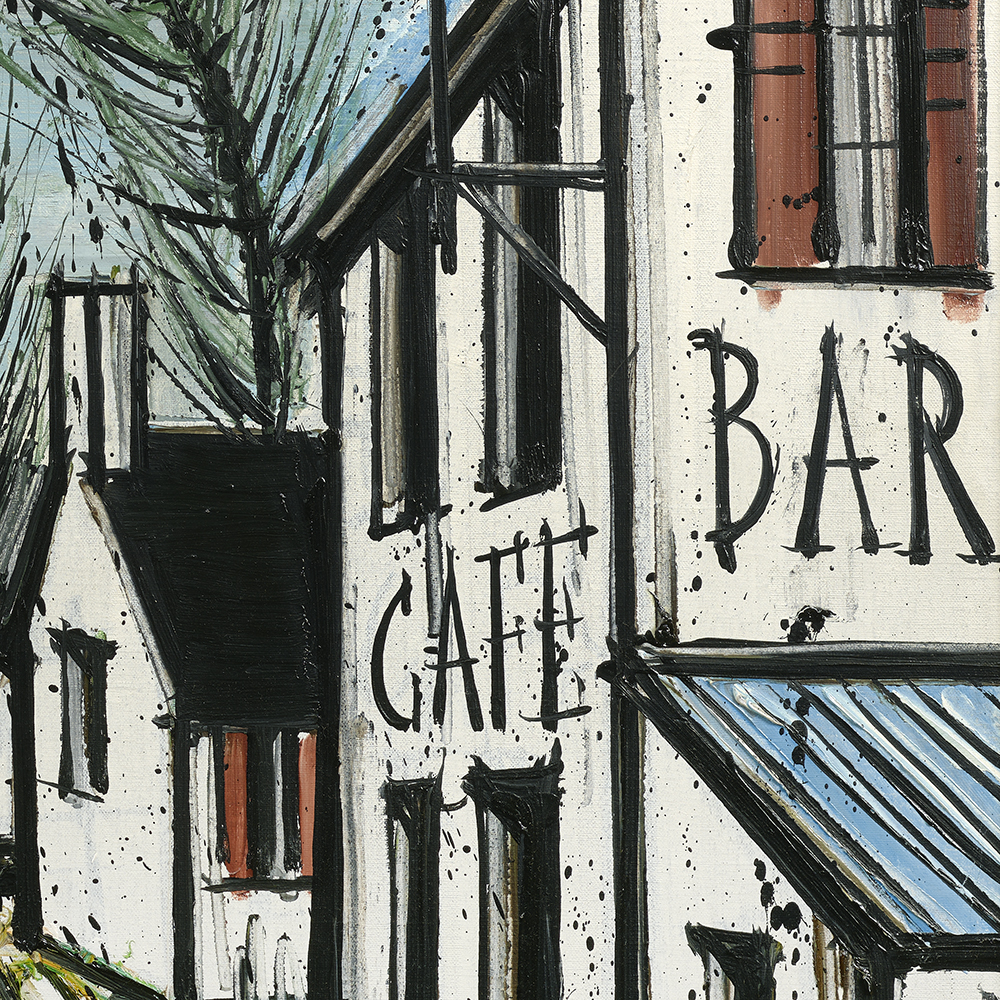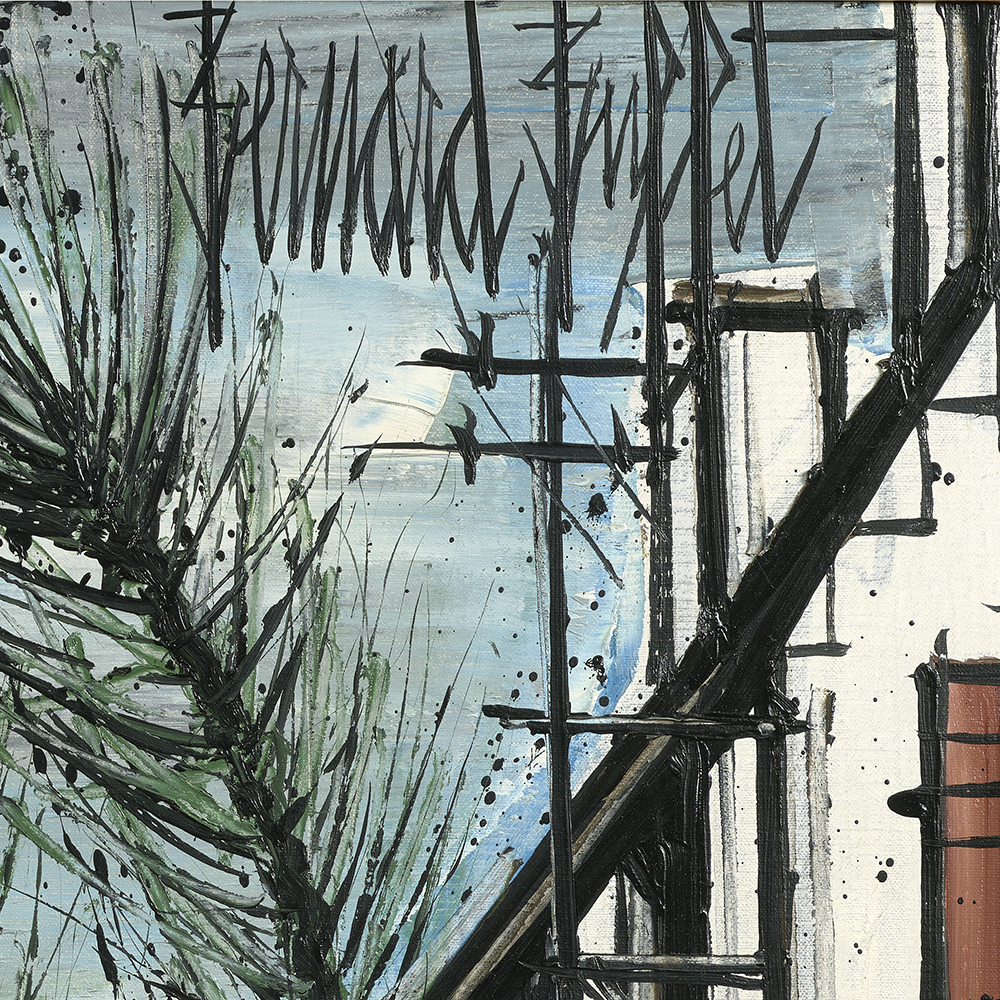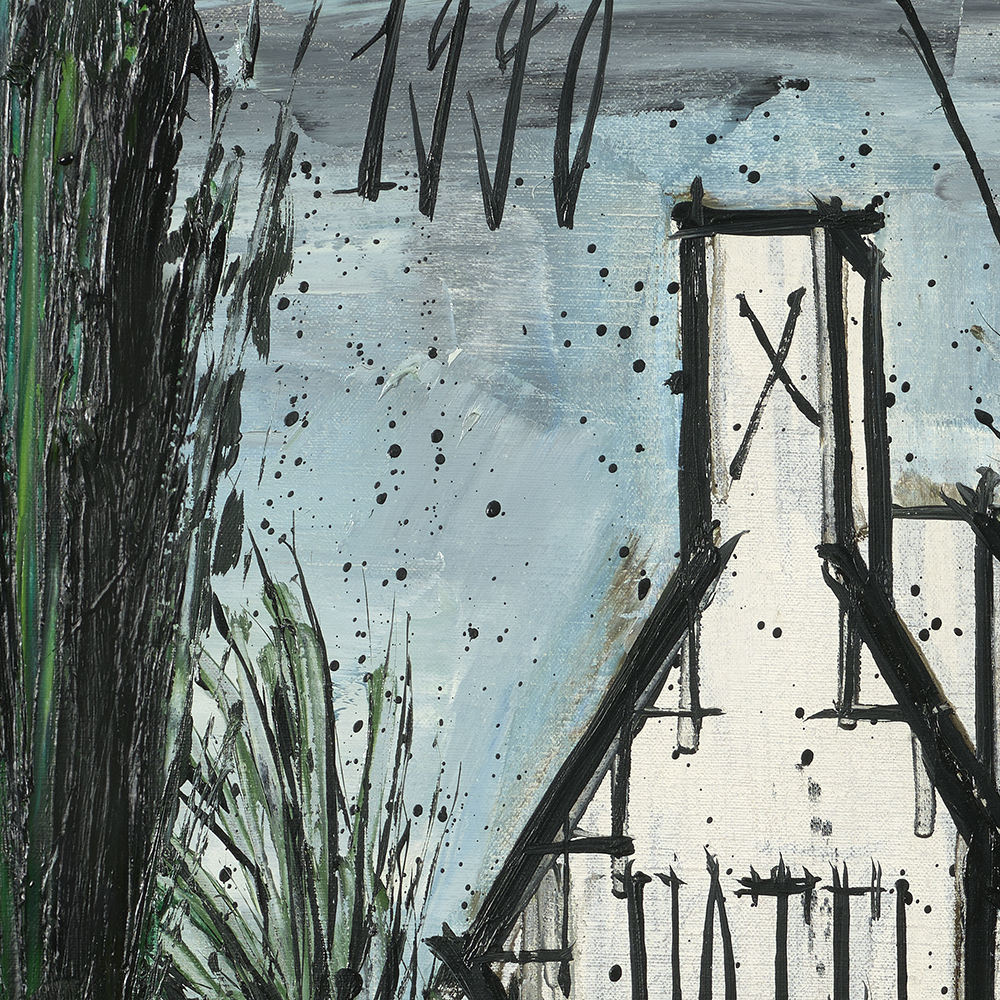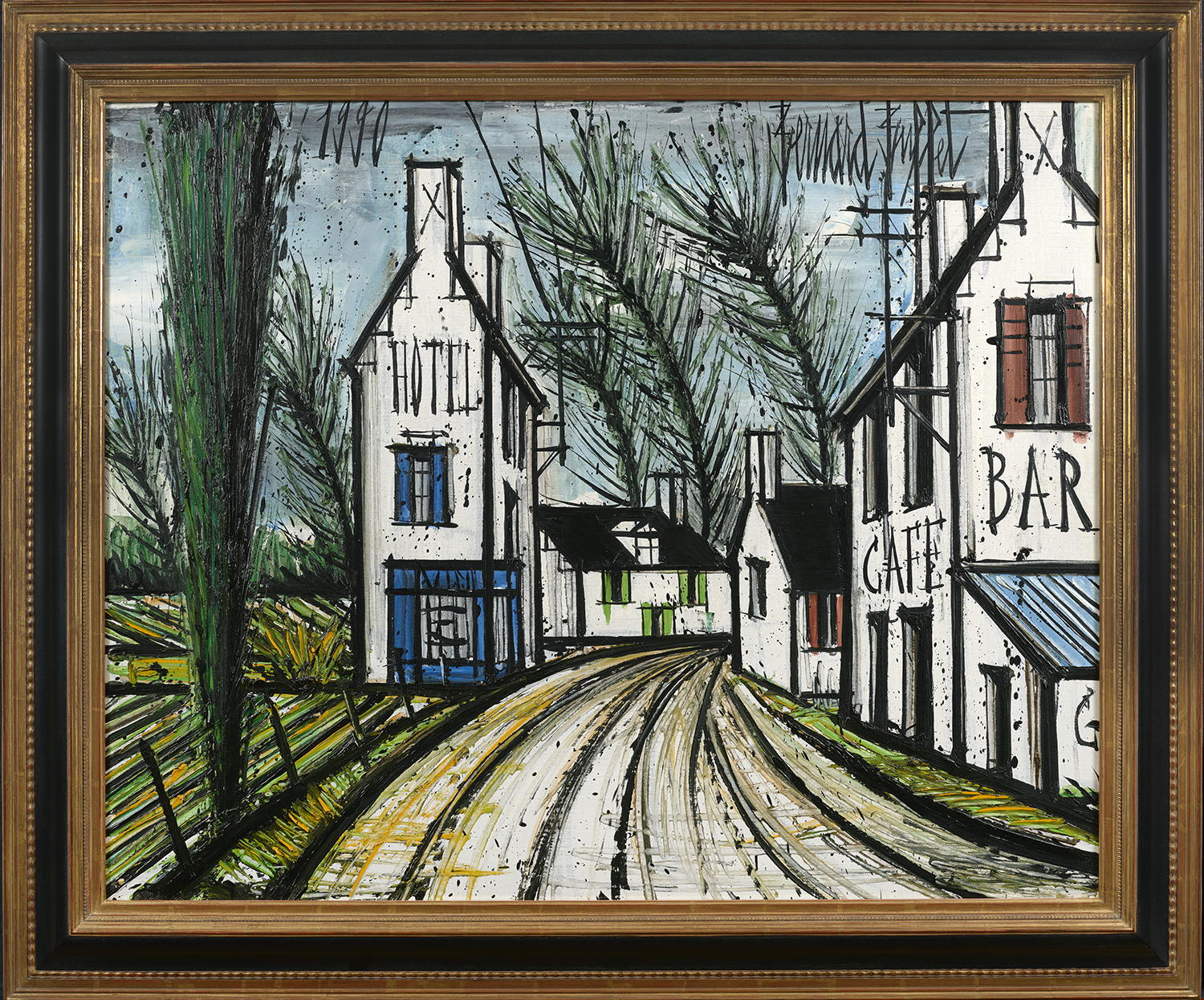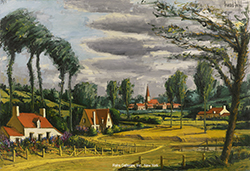Bernard Buffet
(1928 - 1999)
Hôtel, café, bar
Oil on canvas
32 x 39.5 inches
Framed dimensions:
39.5 x 47 inches
Signed and dated 1990
BIOGRAPHY - Bernard Buffet (1928 - 1999)
The Buffet family exemplified the life of the Parisian bourgeoisie of the 1920s. The artist’s father Charles worked as a manager for the Guenne et Gilquin mirror and glass factory and his mother Blanche oversaw the household and her sons education. Charles had hoped to follow his father into the military, but he failed his entrance exams for Saint-Cyr, the prestigious military academy founded during the Napoleonic era. Fortunately, the preparation for his exams included spending time in Germany to learn the language and customs of France’s historical foe; these skills earned him a job as an official translator for the city of Cambrai during World War I. Although he was not part of the armed forces, Charles Buffet would have experienced the devastation from battles of the Western Front all around him.
In 1919, he returned to Paris to marry his childhood sweetheart, Blanche Colombe at the newly built Church of Saint-Michel-des-Batignolles. They settled in the seventeenth arrondissement, a neighborhood that would be home to the family for many decades to come. Their first son, Claude arrived in 1924 followed by Bernard on July 10, 1928. By all accounts, Bernard Buffet’s childhood was less than idyllic. His father routinely divided his time between his mistress, Marguerite Samson, who worked as a pharmacist, and his family. Although this arrangement was considered acceptable in 1930s France, Blanche was understandably discontented. Her response was to concentrate her affections on her sons and her church.
One of the happier recollections of Buffet’s childhood were frequent trips with his mother and brother to the Louvre on Sunday afternoon. After a morning at church and lunch with the family, the three of them would set out to explore the museum, paying special attention to the early nineteenth century paintings of Antoine-Jean Gros (1771-1835). Buffet would later remark that Gros was the “true master of Géricault and Delacroix”, adding that he was “without doubt the master of history painting.” [i] In particular, the young Buffet was fascinated by The Pesthouse at Jaffa (Les Pestiférés de Jaffa), 1804, a monumental canvas depicting Napoleon’s visit to the Saint Nicholas monastery in Jaffa where many of his soldiers lay dying from bubonic plague. To an adult viewing the painting, it may well have been clear that it was as much propaganda as history, but to a young boy, it was the depiction of a revered hero, a compassionate military leader who was unrelentingly brave in the face of death. As a mature artist, Buffet would admire the painting for its sophisticated composition and color—with perhaps a tinge of that childlike admiration he’d once experienced.
Buffet’s educational experiences at the Jesuit school on the rue de Madrid just south of the family home on the rue Batignolles, were considerably less positive. He was frail and apparently quite uncommunicative in class, although he did show an aptitude for drawing from the time he was about seven years old. Likewise, his after-school activities were supervised by his mother, whose preoccupation with social standing meant that she took her sons to play in the tony Parc Monceau. Her hope was that they would meet children from wealthier families, but the result was primarily that the boys were not allowed to run around and play as they might have in the nearby neighborhood park.
There were happier times during school holidays. At Christmas and Easter, the family often traveled to Le Quesnoy near the Belgian border where Buffet’s paternal grandmother lived. And during the summer, they typically spent ten weeks at Saint-Cast, a tiny port on the English Channel in Brittany. Buffet loved the sea and seems to have felt free to run and play without constraint. When France declared war on Germany on September 1, 1939, the Buffet family was still enjoying the beaches of Brittany. Rather than return to Paris, Blanche decided to remain in Saint-Cast and enrolled Claude and Bernard at the local school in nearby Dinan. They rented the first floor of a house from a local fisherman named LeClerc and settled into village life. LeClerc turned out to be an important influence in Buffet’s life; he introduced the boy to the pleasures of seafood as well as fishing and a more active lifestyle. Images of fishing and sea creatures would reappear in the artist’s work throughout his life.
Although the Nazi occupation of Paris was deeply frightening, it became clear within a year that they were not likely to destroy the city; indeed, they seemed to be more concerned about enjoying the pleasures of Paris, however limited. Armed with that information, Blanche returned home in late fall of 1940. She enrolled her youngest son in the Lycée Carnot, a prestigious school where she hoped he would be molded into a successful businessman. Buffet’s tenure there was short. In the summer of 1943, he was asked not to return. As in his primary school years with the Jesuits, Buffet simply wasn’t interested in studying. The only subject he enjoyed was natural history where he was allowed to draw various animals and bugs. His teacher, Jean Roy, even tried to encourage him by taking him to the Natural History Museum every Thursday, but without much success. The headmaster’s letter to his mother read: “...young Bernard is gifted in no subject whatsoever, except perhaps in drawing.” [ii]
The next attempt at education was an evening drawing class at a municipal school in the Place des Vosges. There, professor Victor Sacha Darbefeuille (1886-1975) introduced Buffet to the tradition of drawing from antique plaster casts. [iii] In a few short months, Buffet was admitted to the École Nationale Supérieure des Beaux-Arts, where he had to obtain a special dispensation because he was only fifteen years old. He was assigned to the studio of Eugène Narbonne (1885-1973) where he met Robert Mantienne, Jean-Pierre Capron and Agnès Nanquette; having friends who shared his interests was a new experience for the usually withdrawn teenager. In spite of the Nazi occupation of Paris and the non-stop daily war news, Buffet was happy and productive at the École. He studied seventeenth century Dutch still-lifes and the street scenes of Maurice Vlaminck and Maurice Utrillo as well as drawing and painting techniques.
In the summer of 1945, Buffet and his mother returned to Saint-Cast for vacation; his brother Claude was a soldier fighting in Germany and his father remained in Paris “to look after his mistress and his glass factory”. [iv] Mother and son seem to have enjoyed themselves until August when Blanche was diagnosed with a brain tumor. She was admitted to hospital and told that she could not be moved back to Paris. The seventeen-year-old Buffet returned to school in September, leaving his mother in the care of the nursing sisters in Brittany. She died on October 30, 1945 without returning to Paris or seeing her family again. [v]
By the beginning of 1946, Buffet reached a turning point in his young life. The war was over; his mother was dead; he was alienated from his father and brother; and his career was about to begin. Although he was not yet eighteen, he was encouraged by Jean Aujame, one of the jurors for the École, to submit a painting to the Salon des Moins de Trente Ans (salon for those under thirty years old). Buffet sent a self-portrait in pale browns, whites and greys, a monochromatic palette that would characterize much of his early work. At the same time, he developed a process for painting miniatures that he could sell in bulk—50 miniatures for 1500ff (30ff each)—more than enough to cover his modest living expenses. The small canvases consisted of sentimental images of bouquets, circus figures or “rococo” characters surrounded by frames with fake pearls. Buffet would paint one subject repeatedly and then go on to the next subject, creating a kind of assembly line production for himself.
His personal life was more lively as well. He and his classmate Robert Mantienne had become good friends, and together, they sampled the nightlife of post-war Paris as well as the newly re-opened galleries and museums. Mantienne was four years older than Buffet and had considerable more experience of the world; he had been active in the Résistance and, as a result, he was a prisoner of the Nazis for six months in 1943. After completing his studies at the École, Buffet would work in Mantienne’s studio in Massy- Palaiseau south of the city. His 1945 portrait of his friend captures Mantienne in front of his easel, staring intently at the image emerging on the canvas. Unlike the attenuated monochromatic figures that would soon appear on Buffet’s easel, this portrait reveals the artist’s desire to capture the spirit of his friend without exaggeration or stylization.
In 1947, Buffet would make his debut at the Salon des Indépendants and at the Salon d’automne. In December, his first solo exhibition opened at the Librairie des Impressions d’Art on the rue des Écoles in the Latin Quarter. The show was organized by the founders of the magazine Arts et Lettres, Guy Weelen and Michel Brient; and the respected critic and art historian Pierre Descargues wrote the preface to the exhibition catalogue. Although the exhibition did not draw large crowds, it was a critical success, resulting in the purchase of Le Coq mort (Dead rooster) by Raymond Cogniat for the Musée national d’art moderne. [vi] Buffet was beginning to build a reputation as a new and promising artist.
The following year, he came to the attention of Emmanuel David, one of the partners in the Galerie Drouant-David, who was intrigued with Le Buveur, Buffet’s submission to the Salon des Indépendants. David proposed that Buffet work with his gallery on a regular basis, beginning with a one-man show in February 1949. That relationship would continue until Buffet’s death.
One of the oddest events of 1948 was Buffet’s marriage to Agnès Nanquette, a former classmate from the École. The couple married on November 23, 1948, moved to the west suburban village of Garches and divorced after only a few months. Based on the multitude of photographs documenting Buffet’s later life, the two seem to have remained cordial after their parting. Nanquette continued to work as a painter and illustrator for many years.
Buffet’s private life would change radically in 1950 when he met a young journalist recently arrived in Paris. Pierre Bergé (1930-2017) had moved to the city in 1949 and fallen into a job as the editor of a left-wing magazine after spending the night in jail with Albert Camus for participating in a demonstration. The two men shared a coffee at a local cafe the next morning and struck up a friendship. Although the magazine was short-lived, Bergé met a number of like-minded individuals through his editorial work, including Jean Cocteau, Christian Dior and Bernard Buffet. [vii] Before the year was out, Buffet and Bergé had become lovers. For the first time in his life, Buffet enjoyed a long-term relationship that seems to have been relatively stable.
In 1950 Buffet also became a member of the organizing committee for a group of young artists who were dedicated to figural and realist painting. They would host an annual exhibition called the Salon des Jeunes Peintres (Salon of the Young Painters) at the Galerie des Beaux-Arts. The impetus for this group was the perception that Paris had lost its position as a global art center following World War II and that abstract art was an aesthetic and philosophical dead end. As Pierre Descargues explained, it was essential for young artists to leave the “reign of death” they’d experienced during the war years and “shout their joy with more sonorous colors, with the most marvelous models, to open up the pleasure of reclaiming those most marvelous skills of the painter: colors and lines in the service of life”. [viii] It was not a call to return to academic traditions, but to express modern life through art that was based on daily experiences and depicted in a manner that was representational. Buffet would continue to exhibit with this group and to support these ideas until 1955.
The early 1950s were also the period in which Buffet first begins to live part of the year in Provençe. In 1951, he and Bergé moved into a farmhouse owned by the writer Jean Giono (1895-1970) in Manosque, a town twenty-seven miles northeast of Aix-en-Provençe. Giono was a respected, if somewhat controversial, middle-aged author when Buffet met him, but the two became lifelong friends. [ix] The farmhouse provided a quiet retreat from the city life of Paris as well as a respite from the grey skies and rainy days of winter. The following year, Buffet moved his atelier even further into the country when he purchased a sheep barn in Nanse. He would work there periodically until 1955.
Back in Paris, Buffet’s reputation grew ever wider, as the Galerie Drouant-David began to exhibit his work in London and New York. In conjunction with the annual Buffet show, Emmanuel David developed the practice of installing an exhibition of works on paper at Maurice Garnier’s Galerie Visconti at 35 rue du Seine not far from the École. This provided Buffet with a venue for his work on both the right and left banks of the city.
Between 1952 and 1958, Buffet’s works were exhibited at the Salon des Jeunes Peintres, the Salon des Tuileries, the Salon des Peintres témoins de leurs temps (Salon of painters of contemporary life) and the Venice Biennale. His paintings would be seen in Geneva, Zurich, Venice, New York, London, Milan, Rome, Amsterdam and at the Galerie Lucien Blanc in Aix-en-Provençe. In short, he was fast becoming an international figure whose distinctive style found patrons everywhere. Throughout this flurry of exhibitions, Buffet would present his work on a specific theme every February at the Galerie Drouant-David and Galerie Visconti.
His reception among the general press was extensive as well. The fashionable magazine Paris Match announced that Buffet was ‘number one’ in a poll of the top ten post-war artists conducted by the art journal, Connaissance des Arts in 1955. [x] A year later, Paris Match published a ten-page article on Buffet at his newly acquired manor house fifteen miles north of Paris. Photographs of the artist next to his Rolls Royce—with glimpses of the manor house in the background—created a sense of luxurious prestige and sophistication while the captions touted Buffet as “the most expensive post-war painter, who at age 28 has painted more than Renoir, who died at 79.” [xi]
The art press, both popular and scholarly, was equally enthusiastic about Buffet’s work. Simultaneous with the February exhibition at Drouant-David in 1956, Art et style devoted its entire issue to the “Cirque de Bernard Buffet”; circus images were the theme of the exhibition that year. In addition, at the Venice Biennale XXVIII curated by Raymond Cogniat, an entire gallery was dedicated to Buffet’s work, and he was described in the accompanying catalogue as the leader of the young painters of France.
At age twenty-eight, Buffet had an abundance of worldly success and the adulation of critics, scholars, collectors and the general public. Even by contemporary celebrity standards, he was indeed a star. In the midst of such fame and fortune, he again decided to buy a place in the country, only this time it was the Château l’Arc, an estate outside of Aix-en-Provençe overlooking Mont Sainte-Victoire. This would become his primary residence until 1964.
It must be mentioned that starting in 1955, Buffet began designing sets and costumes for theatrical productions. His first foray into the world of theatrical design was for La Chambre, a ballet choreographed by Roland Petit with a libretto by Georges Simenon. He would continue to work as a designer periodically throughout his career, including a stint working with another enfant terrible, Françoise Sagan, on the ballet, Le rendez-vous manqué (The broken date), which opened at the Théâtre des Champs-Elysées on January 21, 1958. That same month Buffet also worked with Pierre Bergé to help a young fashion designer prepare for the premiere of his first solo show at the House of Dior; that designer was Yves Saint Laurent.
On a personal level, 1958 was full of profound change. Buffet’s relationship with Bergé was beginning to disintegrate, largely because of the presence of Yves Saint Laurent. In later years, Bergé himself would say that meeting Saint Laurent was a defining moment in his life. [xii] Buffet was less than thrilled with this development and their eight-year relationship soon collapsed. Bergé and Saint Laurent became a couple immediately and Buffet began dating a young writer named Annabel Schob. When they married on December 12, 1958 in Ramatuelle near Saint-Tropez, it was front page news throughout the world. In spite of what might seem like a whirlwind courtship, the marriage lasted until Buffet’s death years later.
At the age of thirty, Buffet had accomplished more than most people do in a lifetime, but he seems to have paused to reflect as he entered his fourth decade. Most notably he stopped exhibiting at all Paris salon venues, with the exception of the Peintres témoins de leur temps, in 1959. There were undoubtedly multiple issues that Buffet was contemplating as he stepped back from what had been a very public life. Perhaps he had grown weary of the unrelenting spotlight of celebrity life. Perhaps he wanted to spend time creating a strong and sturdy relationship with his new wife. Perhaps he simply realized that he had made enough money to be financially secure for a lifetime and chose to focus his attention on the work and people who mattered most to him.
Regardless of Buffet’s reasons, it soon became clear that he was no longer the darling of the French art establishment. An exhibition at the Musée de la Vielle Charité in Marseilles in 2009 addressed this issue directly when it mounted the first major French retrospective of Buffet’s work since the late 1960s. Henry Périer, curator of the show, noted that Buffet had fallen afoul of President DeGaulle’s minister of culture, André Malraux, in part because of the artist’s refusal to support the abstract art movements of his day. According to Périer, "Malraux was determined to re-establish the reputation of Paris as the art centre of the world. He decided that the 'abstract' movement of the 1950s was the vehicle which would achieve that aim. Buffet was anything but an abstract painter. His success and his reputation threatened to muddle the argument that the future of art was abstract." [xiii] The other significant adversary was Pablo Picasso, who was outspoken in his criticism of Buffet’s work and more than willing to lead an anti-Buffet campaign within the arts community of Paris. It does not seem to have occurred to either Picasso or his audience that a wildly successful artist in his eighties might appear just a bit foolish attacking a fellow-artist over fifty years his junior.
In spite of the art world politics surrounding Buffet, he does not appear to have been unduly troubled by them. Without fail, he produced an annual solo show in February with Emmanuel David and Maurice Garnier, who had opened a new gallery just north of the Champs-Elysées in 1956. Occasionally Buffet would also participate in specialized exhibitions at the Galerie Charpentier. And he continued to design sets and costumes for ballets and operas, as well as producing an increasing number of book illustrations and lithographic portfolios. His contribution to the arts was publicly recognized in 1962 when he became a Chevalier des Arts et Lettres.
The early 1960s also brought the birth of his daughters, Virginie in 1962 and Danielle in 1963. In 1964, he sold his property in Provençe and purchased an estate in Saint-Cast, the seaside hamlet where had spent the happiest days of his childhood. He and his family alternated between Brittany and a new flat in Paris until 1970.
Meanwhile, Buffet’s international reputation expanded appreciably. The decade opened with an exhibition at the Musée de l’Athénée in Geneva followed by another at the Galerie Dresdner in Montreal. In 1962, he had two solo exhibitions in the US, one in Palm Beach and one in Chicago; and in 1963, there was a large display of his work at the Tokyo Museum of Modern Art and the Kyoto Museum of Modern Art. This marked the beginning of what would become a deep connection to Japanese culture. Three years later, his work was again shown in Palm Beach and Chicago as well as in Amsterdam and Brussels. The decade closed with a retrospective exhibition at the Unterlinden Museum in Colmar (Alsace).
The early 1970s found Buffet creating a suite of lithographs with accompanying poems by Paul Verlaine, Arthur Rimbaud and Charles Baudelaire shortly after completing a program to treat his alcoholism. It is tempting to wonder whether Buffet was making an ironic comment about his own substance abuse by choosing poets who were well known for similar behavior. Jeux de Dames consists of a series of images featuring two lesbians, another subject that the nineteenth century poets had addressed directly. [xiv]
Increasingly, Buffet focused his attention on small scale lithographs and on large scale paintings. In the mid-1970s he began a series of seven very large paintings based on Dante’s Inferno which he exhibited at Garnier’s gallery in 1976 along with eleven drypoint illustrations of the text. [xv] The relationship between artist and gallerist changed a year later when Garnier shifted the gallery’s focus exclusively to Buffet’s work, providing the artist with consistent market exposure and financial security. This support allowed Buffet to explore subjects that might not find a ready client.
The seven large paintings of “La Révolution française” from 1978 are one such example. Buffet had long been fascinated by the work of early nineteenth century history painters such Antoine-Jean Gros, and he returned to this subject matter in a series of 20 x 23 foot canvases. Although there was little, if any, demand for history paintings on an epic scale, Garnier’s willingness to exhibit these works made it feasible for Buffet to explore the concepts that defined so much of the history of French art. All of the canvases have compositional echoes of the nineteenth century masters, but the brightly colored clothing and the distorted scale of the figures are entirely contemporary. The Storming of the Tuileries, for example, borrows freely from Delacroix’s Liberty on the Barricades as well as the front page of Le Monde in 1968 when French workers and students took to the streets. [xvi]
Buffet’s habit of buying and selling residences continued throughout the 1970s and 1980s. In 1971 he purchased the Château de Villiers-le-Mahieu about thirty miles west of Paris, a moated chateau complete with an imposing portcullis. Perhaps he hoped it would be an enchanting place to raise his growing family, which by 1973 included his two daughters and a newborn son, Nicholas. He sold this castle in 1978 and returned to live in Paris at 82 boulevard de Courcelles, right across the street from the Parc Monceau where his mother took him as a child. A year later, he once again abandoned Paris for the provinces when he purchased a manor house in Normandy, which he then sold in 1986. The last move was back to Provençe where he bought an estate near Tourtour, about halfway between Manosque where had been introduced to Provence, and Saint-Tropez where he owned an apartment. He also kept a pied-à-terre at 151 avenue de Wagram in the seventeenth arrondissement of Paris from 1981 until 1989 when he bought a house at 20 rue Cortot in Montmartre. This peripatetic life suggests an inexhaustible restlessness. Almost without exception, Buffet moved because he wanted a change, not because he needed to adjust his financial position.
Public recognition of his work continued to grow, even within the circles of French officialdom. In 1971, he became a member of the Légion d’Honneur and on March 13, 1974, he was the youngest member ever elected to Académie des Beaux-Arts. At age forty-eight, he was still breaking barriers in the Parisian art world.
On the other side of the globe, Kiichiro Okano opened the Bernard Buffet Museum in Surugadaira, Japan on November 25, 1973. Okano was introduced to Buffet’s work in the 1950s during a trip to Paris, where the post-war zeitgeist echoed that of Japan. In the wake of the atomic bomb, the existential questions then being posed by Jean-Paul Sartre and Albert Camus over drinks at Les Deux Magots were all too urgent. Okano responded immediately to the anxiety, alienation and sense of emptiness expressed by both the writers and Buffet’s art. As he became increasingly able to purchase paintings and prints, Okano began planning a museum to house his Buffet collection. Today, the museum holds over 2000 objects, the largest single collection of Buffet’s work in the world. [xvii]
Buffet and Annabel would travel to Japan seven times over the years, primarily for exhibition openings at museums in Tokyo and Kyoto as well as at the Bernard Buffet Museum. Their 1980 trip was particularly notable in that Buffet not only created twenty-one paintings for the Galerie Garnier on his return to Paris, but also was asked to design a porcelain service for the Manufacture Bernardaud in Limoges. Like many generations of western artists before him, he would soon find himself incorporating elements of Japanese design and art into his own work. His comments about an exhibition of a series called Oiseuax d’Hokkaido reveals these influences. “I discovered Japan. I deeply love this country, its modern civilization and the refinement of its traditions.” [xviii]
Entering his 50s and 60s in the last decades of the century, Buffet showed no signs of retiring—or even slowing down. Alcoholism remained a challenge for him, but it seems to have had little effect on his artwork. He created several large format painting cycles on topics as diverse as Joan of Arc or the Horrors of War. Annabel served as his most faithful muse, posing as a toreador or a saint, depending on what was required.
Likewise, the couple traveled ever more widely. In addition to trips to Japan, they were in Seoul in 1991 and in Beijing and Taiwan in 1995. Closer to home, they visited Moscow and St. Petersburg in 1991 where an exhibition of Buffet’s work was on display at the Pushkin Museum and the Hermitage Museum respectively.
In 1997, as he was preparing an exhibition of the Joan of Arc cycle for the Musée des Beaux-Arts in Rouen, Buffet noticed that his hands were a bit shaky. It turned out to be an early symptoms of Parkinson’s disease, which would incapacitate him within the next two years. By the fall of 1999, he recognized that he would no longer be able to paint, and so took his own life on October 4, 1999. In contrast to this despair, it may be that Buffet should be remembered for his statement about his own work. “I want you to have a dialogue with my paintings by pure affection. Painting is not something to talk about or to analyze; it is something just to feel.” [xix]
Janet Whitmore, Ph.D.
Selected Museums
Art Institute of Chicago
Bernard Buffet Museum, Surugadaira, Japan
Block Museum of Art, Northwestern University, Evanston, IL
Carnegie Museum of Art, Pittsburgh
Centre Pompidou, Paris
Cleveland Museum of Art
Dallas Museum of Art
Detroit Institute of Arts
Harvard University Art Museums, Cambridge, MA
Indianapolis Museum of Art
Metropolitan Museum of Art, New York
Musée Danicourt, Péronne, France
Musée d’Art et d’Histoire Louis Senlecq, L’Isle-Adam, France
Musée d’Art Moderne, Troyes, France
Musée de Grenoble
Musée des Beaux-Arts, Bordeaux
Musée des Beaux-Arts, Nantes
Musée des Beaux-Arts, Lille
Musée des Beaux-Arts, Rouen
Museum of Fine Arts, Boston
Museum of Fine Arts, Houston
Museum of Modern Art, New York
National Gallery of Art, Washington DC
National Gallery of Victoria, Australia
Nelson-Atkins Museum of Art, Kansas City, MO
Smithsonian Museum of American Art, Washington, DC
Tate Modern, London
Notes
[i] Nicholas Foulkes, Bernard Buffet: The Invention of the Modern Mega-artist, (New York: Random House, 2016). Cited in chapter 2, “The Boy from Les Batignolles”. See also note 10, Bernard Buffet, “La Leçon de J. A. Gros”. Some sections of the book are also available at: https://books.google.com/books?id=yvYfCwAAQBAJ&printsec=frontcover#v=onepage&q&f=false
[ii] Janet Flanner, “Le Gamin”, The New Yorker, 21 November 1959.
[iii] Dominique Gagneux, Rétrospective, Bernard Buffet (Paris Éditions Paris Musées in association with Flammarion, 2016) 16. Exhibition catalogue.
[iv] Foulkes, Bernard Buffet: The Invention of the Modern Mega-artist, chapter 3.
[v] Blanche’s funeral was held in the cathedral of Sainte-Brieuc in Brittany and she is buried there.
[vi] Raymond Cogniat was the “inspecteur des Beaux-Arts” in the mid-twentieth century, a state administrative position that has its roots in the creation of the Surintendance générale des Bâtiments du Roi et des Arts et Manufactures in 1664 under Louis XIV. It was a prestigious position with significant power over matters pertaining to architecture, the arts and design. Under the third Republic (1870-1940), the position was redefined as a public service function dealing with cultural matters. Today it is part of the Ministry of Culture. In Buffet’s time, the “inspecteur générale” was a key figure in allotting government commissions and in deciding what artworks would be purchased for the national network of French museums. For a short history of this position, see Marie-Claude Genet-Delacroix, “Histoire et fonction de la direction des Beaux-Arts (1870-1905)” Romantisme, revue du dix-neuvième siècle, 1996, No. 93, 39-50.
[vii] Jonathan Kandell, “Pierre Bergé, Transformative Fashion executive and Opera Czar, Dies at 86” The New York Times, September 8, 2017.
[viii] Cited in Francis Parent and Raymond Perrot, La Salon de la Jeune Peinture, Une histoire, 1950-1983 ( Issy les Moulineaux, France: Patou, 2016) 7. [Chanter leur joie par les plus sonores couleurs, par les modèles les plus merveilleux, pour faire s’épanouir le plaisir de retrouver ce merveilleux métier de peintre: couleurs et lignes au service de la vie.]
[ix] Buffet would create a suite of twenty drypoint engravings to illustrate Jean Giono’s Recherche de la Pureté in 1953. See Lydia Harambourg, Bernard Buffet (Paris: Fonds de dotation Bernard Buffet, 2013) 218.
[x] Connaissance des Arts, No. 36, 15 février 1955.
[xi] René-Jean Ottoni and Maruice Jarnoux, Paris Match, No. 356, 4 février 1956.
[...le plus cher des peintre d’après-guerre, qui à 28 ans a peint plus que Renoir mort à 79 ans.]
[xii] Jonathan Kandell, “Pierre Bergé, Transformative Fashion executive and Opera Czar, Dies at 86” The New York Times, September 8, 2017.
[xiii] John Lichfield, “Bernard Buffet: return of the ‘poser’” Independent, March 16, 2009. Also available online at: https://www.independent.co.uk/arts-entertainment/art/features/bernard-buffet-return-of-the-poser-1645748.html
[xiv] André Sauret, ed. and Bernard Buffet, Jeux de Dames (Monte Carlo: Les Éditions du Livre, 1970).
[xv] Emmanuel David and Maurice Garnier ended their partnership in 1968 and Garnier assumed sole control of what became the Galerie Garnier. He would maintain the tradition of an annual one-man show of Buffet’s work on a single theme until 1977 when he decided to focus exclusively on the Buffet’s art. Today, his widow and gallery staff maintain the Buffet collection through a comprehensive website at: http://www.museebernardbuffet.com/site.html (English and French versions).
[xvi] See Galerie Garnier’s website for an image of La prise des Tuileries at: http://www.museebernardbuffet.com/7180.html
[xvii] The website for the museum offers an excellent introduction to Buffet’s work in both Japanese and English. See The Bernard Buffet Museum.
[xviii] Gagneux, Rétrospective, Bernard Buffet, 181. [J’ai découvert le Japon, j’aime profondément ce pays, sa civilisation moderne et le raffinement de ses traditions.]
[xix] This statement is printed on the wall of the Bernard Buffet Museum in Japan. See The Bernard Buffet Museum.
| AVAILABLE WORKS | ||

